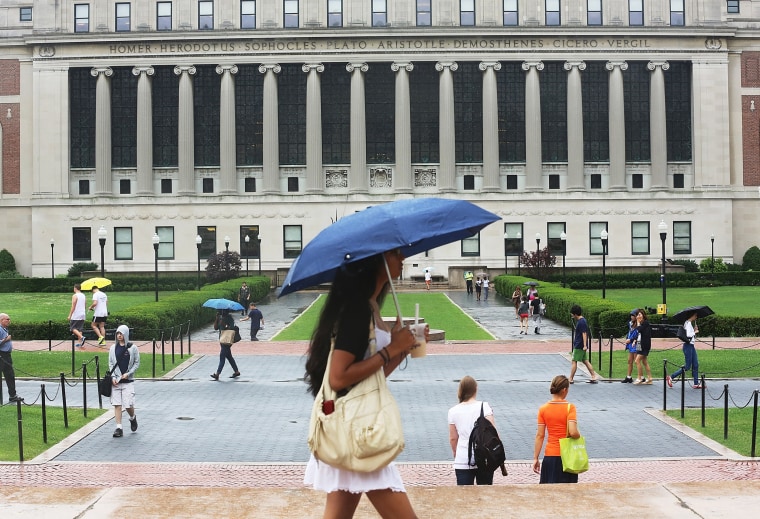Students who need to borrow from the federal government to pay for college this fall will get hit with significantly higher interest rates. And the financial burden on lower-income students could increase even more if Congress approves President Donald Trump’s plan to eliminate subsidized student loans.
The new interest rates on loans for the upcoming academic year are expected to be:
- Stafford Loan – undergraduate: 4.45 percent, up from 3.76 percent
- Stafford Loan – graduate students: 6 percent, up from 5.31 percent
- Parent PLUS loans: 7 percent, up from 6.3 percent
These are fixed rates that apply to new loans made between July 1, 2017 and June 30, 2018. The rates on existing loans will not change. And unfortunately, you cannot take out loans for the new school year at current rates.

Note: The federal government has not officially announced the new rates. Student loan experts have calculated the change using the Department of Education’s formula which is based on the rate of the 10-year Treasury note.
“The rates are going up because the Federal Reserve has started raising interest rates at a regular pace and we can expect that they’ll continue to go up,” said Mark Kantrowitz, the publisher of Cappex, a website that helps families search colleges and the scholarships. “I wouldn’t be surprised if we see an increase in the federal student loan interest rates each of the next few years of between half and three-quarters of a percentage point.”
Interest rates on federal student loans have been historically low for many years now. This is the first increase since 2014. An undergrad who borrows $10,000 at the new interest rate would pay an extra $3.29 a month or $395 more in interest over 10 years, according to the student loan calculator at NerdWallet.
“This small jump in the interest rate of the loan is not going to be a deal breaker for most students,” said Penelope Wang, deputy money editor at Consumer Reports. “The bigger problem is the overall student debt in the U.S. and this certainly does not make the situation any better.”
President Trump Wants to End Subsidized Student Loans
Student loan experts are worried about the impact of the president’s proposed budget that calls for eliminating subsidized student loans for lower-income students. At a time when the nation is trying to find ways to make college more affordable, this would drive up the cost for millions of Americans.
Subsidized Stafford loans help lower the high cost of higher education for about six million students a year because the interest doesn’t start to accrue while the borrower is in school and for six months after graduation.
Subsidized loans also offer an interest-free grace period of up to three years for someone who is on active duty military service, unemployed or having some other qualified financial hardship.
“Removing the subsidy is equivalent to almost doubling the effective interest rate on these subsidized loans,’ Kantrowitz told NBC News. “About half of all students graduate with some amount of subsidized Stafford loans — the average for a Bachelor’s degree is around $13,000 — so that is going to increase the cost of paying for college much more so than the change in the interest rates.”
In a recent blog post, The Institute for College Access & Success criticized the Trump administration’s budget proposal:
“At a time where there is growing public concern about rising student debt and broad consensus on the importance of higher education and post-secondary training to the US economy, we need to be doing more, not less, to keep college within reach for all Americans.”
Related: A College Tour Guide's Top Tip for Parents
TICAS, an independent and non-profit organization that works to make higher education affordable for people of all backgrounds, ran the numbers on the impact of eliminating these subsidized loans.
“For the average student who borrows $23,000 and graduates within five years with a BA, they start out with $3,400 more in debt than they would otherwise. Over the life of the loan, we see even greater costs in terms of the total cost of borrowing,” said Jessica Thompson, TICAS policy and research director. “This would be a really big cut for no real reason. It’s not being reinvested in a different way to reduce college costs for low-income students, so we are very concerned about this.”
As Consumer Reports explains in a recent blog post, the proposed White House budget calls for “a major restructure” of the federal student loan program in ways that could hurt borrowers struggling to make their payments. It would end public-service loan forgiveness and overhaul the programs that allow income-driven repayment plans.
The Growing Burden of Student Loan Debt
The steadily increasing price of higher education — and the growing cost of borrowing to pay for it — is taking a toll on the nation’s psyche. Americans currently owe $1.4 trillion dollars in student loan debt. Experts say this is putting a strain on family budgets as well as the U.S. economy.
Sixty-nine percent of all Americans lack confidence that everyone who seeks higher education will be able to pay for it, according to the latest Consumer Voices Survey by Consumer Reports.
Bankrate.com recently surveyed 1,000 people about their financial regrets. While the most common regret is not saving enough for retirement, taking on too much student loan debt topped the list for millennials (27-36 years old).
“This is an unsustainable situation as far as the amount of student loan debt we’re racking up, and I really hate to see millennials and their parents getting hit with these payments that can go on for decades,” said Mark Hamrick, Bankrate’s senior economic analyst. “Colleges and universities by and large have become conditioned to expect that students and their parents will take out these loans no matter what, so it’s as if the escalation in tuition costs will continue forever. And I would suggest it cannot.”
Financial experts have this advice for students and families who need loans to pay for college:
- Don’t borrow more than you can realistically repay: Here’s the rule of thumb. Try not to borrow any more than your expected annual starting salary after graduation. If your total debt at graduation is less than your annual income, you can afford to repay your student loans in 10 years or under.If you need to look beyond federal loans, you should think twice about the cost of the college you’re considering, Consumer Reports cautions readers. In that case, you may be taking on much more debt than you can comfortably repay.
- Try to avoid private loans: Private loans are typically variable rate. Federal loans have a fixed rate. Even with the interest rate hike, federal loans are still a good deal.“Any federal loan is preferable to taking out a private loan,” Jessica Thompson at TICAS told NBC News. “We consider private loans akin to putting your education expenses on a credit card. They are really something to avoid if at all possible.”In most cases, the student requires a parent or grandparent to cosign for that loan, which puts their credit on the hook.
Cappex has a detailed article outlining the differences between federal and private student loans.
Related: Cosigning a Loan? Your Credit Score Will Drop and You'll Retire Later
Federal loans also come with many protections that private loans rarely provide, such as repayment options that can see you through hard times.
The most important thing families can do is to save for college, Mark Kantrowitz at Cappex told NBC News, so they can borrow less.
“Every dollar you save is a dollar less you’ll need to borrow. And every dollar you borrow will cost about two dollars by the time you repay the debt. So it’s literally cheaper to save than to borrow,” he said.
Where to Get Help and Guidance
If you need help managing your student loans, contact the American Student Assistance program. They have online tools and can also provide individual counseling.
Many credit counselors can now help people struggling with student debt. You can find a list of certified non-profit student loan counselors on the National Foundation for Credit Counseling website.
The Consumer Financial Protection Bureau site has a variety of student loan resources in its Paying for College section.
Herb Weisbaum is The ConsumerMan. Follow him on Facebook and Twitter or visit The ConsumerMan website.
